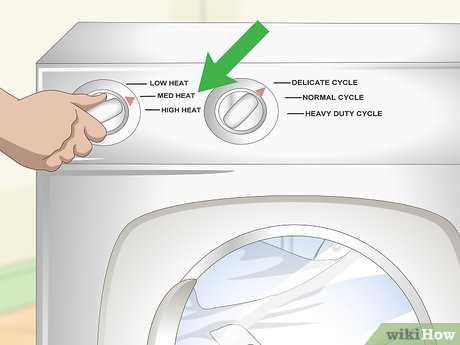




When it comes to doing laundry, understanding the effects of temperature on your clothes is essential. One common concern is whether washing or drying your clothes at a high temperature can cause them to shrink. In this expert guide, we will explore the relationship between temperature and shrinking clothes, both in the washing machine and the tumble dryer.
So, what temperature actually causes clothes to shrink? The answer depends on various factors, including the fabric type, the garment’s construction, and the manufacturer’s instructions. In general, though, high temperatures, especially hot water or a high heat setting on the dryer, can lead to shrinking.
Hot water can break down the fibers of certain fabrics, such as wool or natural fibers like cotton and linen, which are more prone to shrinkage. The heat causes the fibers to contract, resulting in a smaller size. Additionally, high temperatures can weaken the fabric’s structure, making it more susceptible to shrinking. It’s important to note that synthetic fabrics, like polyester or nylon, are generally more resistant to shrinking, but they can still be affected at extreme temperatures.
In the tumble dryer, the high heat and tumbling action can further contribute to shrinkage. As the fabric heats up, it becomes more flexible and prone to shrinking when subjected to agitation. This is especially true for delicate fabrics or items with a loose weave.
In conclusion, washing or drying clothes at high temperatures can indeed cause them to shrink. It is always recommended to follow the garment’s care instructions and use lower temperatures, especially for delicate or natural fabrics, to avoid shrinking. By taking proper care of your clothes, you can ensure they maintain their original size and fit for longer.
Understanding Fabric Shrinkage
Fabric shrinkage refers to the reduction in size that occurs when fabric is exposed to certain conditions, such as heat, moisture, or mechanical agitation. It is important to understand the factors that contribute to fabric shrinkage in order to properly care for and maintain your clothes.
Factors that Influence Fabric Shrinkage
Several factors can contribute to the shrinkage of fabric:
- Fiber Type: Different types of fibers have different shrinkage characteristics. For example, natural fibers like cotton and wool tend to shrink more than synthetic fibers like polyester or nylon.
- Weave Structure: The way fabric is woven can affect its shrinkage. Tightly woven fabrics are less likely to shrink compared to loosely woven fabrics.
- Fabric Finish: Some fabrics are treated with chemicals or finishes that can affect their shrinkage properties. For example, pre-shrunk fabrics have undergone a special process to minimize shrinkage.
- Temperature: High temperatures can cause fabric to shrink, especially if it is exposed to heat during washing or drying. Hot water and high dryer settings are more likely to result in shrinkage.
- Agitation: Mechanical agitation, such as during washing or drying cycles, can also contribute to fabric shrinkage. Vigorous movements can distort the fabric’s structure and lead to shrinkage.
Preventing Fabric Shrinkage
While some fabric shrinkage is inevitable, there are steps you can take to minimize it:
- Read the Care Label: Always check the care label on your clothes to find the recommended washing and drying instructions. Follow these instructions to prevent excessive shrinkage.
- Use Cold Water: Washing your clothes in cold water can help reduce shrinkage compared to using hot water.
- Air Dry or Low Heat: Consider air drying your clothes or using the lowest heat setting on your dryer to minimize shrinkage. Avoid high temperatures that can cause excessive shrinkage.
- Dry Flat: Certain fabrics, such as knits or delicate materials, may benefit from being dried flat to maintain their shape and prevent shrinkage.
- Size Up: If you are concerned about garment shrinkage, consider buying a slightly larger size to account for potential shrinkage.
Conclusion

Understanding fabric shrinkage is crucial for maintaining the quality and fit of your clothes. By considering factors such as fiber type, weave structure, fabric finish, temperature, and agitation, you can take steps to minimize shrinkage and preserve your garments for longer.
How Temperature Affects Fabric
Temperature plays a crucial role in the care and maintenance of different types of fabrics. The heat can significantly affect the size, shape, and texture of clothes. Understanding how temperature affects different fabrics can help prevent shrinkage and damage to your clothing.
Hot Temperatures
Hot water can cause some fabrics to shrink, especially those made of natural fibers like wool, cotton, and linen. The high temperature can cause the fabric fibers to contract, resulting in a smaller size. When washing clothes, it is advisable to use hot water only for sturdy fabrics that can withstand this level of heat.
In addition to shrinkage, hot temperatures can also fade colors and weaken the fibers. It is generally recommended to wash delicate fabrics, such as silk or lace, in cold or lukewarm water to prevent damage.
Cold Temperatures
Cold water is typically considered safer for most fabrics, as it minimizes the risk of shrinking and color fading. Cold temperatures are most suitable for delicate and synthetic fabrics, such as polyester, nylon, and acrylic. These fabrics tend to be more flexible and less prone to damage caused by heat.
Cold water also helps to preserve vibrant colors and prevent bleeding, especially for garments with bright or dark colors. It is important to note that some stains, oils, or heavy dirt may not come off easily with cold water alone, requiring the use of warm or hot water for effective cleaning.
Drying Temperatures
Heat can also affect fabric when drying clothes in a machine. High heat from the dryer can cause shrinkage, wrinkling, and even melting of certain fabrics. It is advisable to check the fabric care label before using the dryer and opt for low heat or air drying whenever possible.
Some fabrics, like linen or cotton, may require a higher level of heat to remove wrinkles effectively. However, it is essential to be cautious and monitor the drying process to prevent excessive heat exposure that can damage the fabric.
Conclusion
Understanding how temperature affects fabric can help preserve the quality and lifespan of your clothes. It is important to read the fabric care instructions and labels before washing and drying clothes to ensure the appropriate temperature settings are used. By using the right temperature, you can prevent shrinkage, color fading, and damage to your clothing.
Shrinking Clothes in the Washing Machine
When it comes to shrinking clothes in the washing machine, the temperature at which you wash your garments can play a significant role. Higher temperatures can lead to clothes shrinking, especially if they are made from materials that are prone to shrinkage.
Factors that Cause Shrinkage
There are several factors that can cause clothes to shrink in the washing machine:
- Material: Certain fabrics, like cotton and wool, are more prone to shrinkage compared to synthetic materials like polyester. Natural fibers tend to shrink when exposed to high temperatures, while synthetic fibers are more resistant.
- Hot water: Washing clothes in hot water can cause them to shrink. Hot water relaxes the fibers in the fabric, making them more likely to shrink when exposed to heat.
- Agitation: The agitation process during the wash cycle can also contribute to shrinking clothes. When clothes are vigorously agitated, the fibers in the fabric may interlock more tightly, causing the garment to shrink.
- Drying: The drying process, especially using a high heat setting, can further contribute to shrinking clothes. Tumble drying on a high heat setting can cause the fibers to contract and tighten, resulting in shrinkage.
Tips to Prevent Shrinkage
To minimize the risk of your clothes shrinking in the washing machine, here are some helpful tips:
- Read the care label: Always check the care label on your clothes before washing them. The label will provide instructions on the recommended washing temperature and drying method.
- Wash in cold water: Washing your clothes in cold water can significantly reduce the risk of shrinkage. Cold water is less likely to relax the fibers in the fabric, keeping them intact.
- Gentle cycle: When washing delicate or shrink-prone items, use the gentle cycle on your washing machine. This cycle is designed to minimize agitation and reduce the risk of shrinkage.
- Air dry or low heat: Instead of tumble drying your clothes on a high heat setting, consider air drying them or using a low heat setting. This can help preserve the original size and shape of the garments.
Conclusion
Shrinking clothes in the washing machine can be prevented by taking appropriate measures such as washing in cold water, using a gentle cycle, and avoiding high heat settings during drying. It’s essential to understand the material and care instructions for your clothes to minimize the risk of shrinkage.
Shrinking Clothes in the Tumble Dryer
If you’re looking to shrink your clothes, the tumble dryer can be a useful tool. Here are some key points to keep in mind when using the tumble dryer to shrink clothes:
Choose the Right Heat Setting
The heat setting you choose for your tumble dryer can greatly impact the shrinking process. High heat settings are generally more effective in shrinking clothes, as they cause the fibers to contract and shrink. However, extreme heat can also damage and fade the fabric, so it’s important to consider the fabric type and garment care instructions before selecting a heat setting.
Check the Garment Care Label
Before throwing your clothes into the tumble dryer, always check the garment care label. The label will provide instructions on the recommended temperature for drying the garment. If the label specifies a low heat setting or advises against tumble drying, it’s best to follow those instructions to avoid damaging the fabric.
Consider Time and Temperature
The longer you leave your clothes in the tumble dryer, the higher the chance of them shrinking. If you’re aiming for minimal or controlled shrinkage, it’s best to keep a close eye on the drying process and remove the clothes as soon as they’re dry. Additionally, reducing the tumble dryer temperature can help minimize the potential for excessive shrinkage.
Size Up Before Shrinking
When shrinking clothes in the tumble dryer, it’s important to keep in mind that some fabrics may not shrink consistently or evenly. To minimize the risk of ending up with clothes that are too small, it’s a good idea to size up before attempting to shrink them. This will give you some buffer room in case the shrinking process is uneven.
Test with a Sample

If you’re unsure about how a specific fabric will react to the tumble dryer, it’s always a good idea to test a small sample piece first. This will allow you to gauge the shrinking potential without risking damage to the entire garment. Simply cut a small piece of fabric from an inconspicuous area, like a hem or seam, and place it in the tumble dryer.
Be Aware of Limitations
While the tumble dryer can be effective in shrinking clothes, it’s important to note that it may not work for all fabrics. Natural fibers, such as cotton and wool, tend to shrink more easily, while synthetic fabrics like polyester may be more resistant to shrinking. Delicate and intricate garments with embellishments or delicate trims may also be prone to damage in the tumble dryer.
By following these tips and being mindful of the fabric type and care instructions, you can safely and effectively shrink clothes in the tumble dryer. Always remember to check the garment care label and test with a sample if you’re unsure about the fabric’s reaction to heat.
Preventing Fabric Shrinkage
Shrinkage is a common issue when it comes to washing and drying clothes, but there are several steps you can take to prevent it. Here are some tips to help you avoid fabric shrinkage:
1. Read the garment care label
Before washing any garment, always check the care label for specific instructions. Some fabrics are more prone to shrinkage and require special care. The label will provide information on the recommended temperature, drying method, and any special precautions to take.
2. Wash in cold water

Hot water can cause fabrics to shrink, especially natural fibers like cotton and wool. To reduce the risk of shrinkage, always wash your clothes in cold water. This helps to preserve the fabric’s shape and prevent excessive shrinking.
3. Use a gentle cycle

Avoid using the regular or heavy-duty cycle on your washing machine when washing delicate fabrics. Instead, opt for the gentle or delicate cycle. This reduces the agitation and friction, which can cause shrinkage.
4. Air dry whenever possible

Tumble drying is one of the main culprits of fabric shrinkage. Whenever possible, air dry your clothes to prevent shrinkage. Hang them on a clothesline or drying rack, making sure to reshape them if needed. If you must use a dryer, select a low heat setting.
5. Avoid over-drying
If you choose to use a dryer, avoid over-drying your clothes. Remove them from the dryer while they are still slightly damp. Over-drying can cause the fibers to tighten and shrink. Consider using a moisture sensor or timer to prevent excessive drying.
6. Test new fabrics

When purchasing new fabrics or clothes, it’s a good idea to test them for potential shrinkage before washing or wearing them. Take a small, inconspicuous area of the fabric and wash it according to the care instructions. If it shrinks significantly, you may want to consider alternative cleaning methods or avoid purchasing the fabric altogether.
7. Hand wash delicate items
Delicate fabrics like silk or lace are best washed by hand to prevent shrinkage. Fill a sink or basin with cold water and a gentle detergent specifically designed for delicate fabrics. Gently agitate the garment in the soapy water and rinse thoroughly. Avoid twisting or wringing it out, as this can cause damage and shrinking.
8. Avoid high heat ironing
If you need to iron your clothes, avoid using high heat, especially on fabrics that are prone to shrinking. Use the lowest temperature setting necessary to remove wrinkles and always iron the garments inside out to protect the fabric.
By following these tips, you can significantly reduce the risk of fabric shrinkage and preserve the size and shape of your clothes.
FAQ
What is the ideal temperature to wash clothes?
The ideal temperature to wash clothes depends on the fabric. Most clothes can be washed at a temperature between 30-40 degrees Celsius.
Will washing clothes at high temperatures shrink them?
Yes, washing clothes at high temperatures can cause them to shrink. It is best to check the care instructions on the clothing label to determine the recommended washing temperature.
Can clothes shrink in tumble dryers?
Yes, tumble dryers can cause clothes to shrink if they are exposed to high heat for a prolonged period of time. It is advisable to follow the care instructions and use the appropriate setting on the tumble dryer.
What temperature should I set my tumble dryer to prevent clothes from shrinking?
To prevent clothes from shrinking in a tumble dryer, it is recommended to use the lowest heat setting or the “delicate” setting. Air drying is also a good alternative to avoid shrinkage.
Can clothes shrink if washed in cold water?
Clothes are less likely to shrink when washed in cold water compared to hot water. However, some fabrics may still shrink if subjected to agitation or if they are not properly cared for. It is best to follow the care instructions provided by the clothing manufacturer.
At what temperature should I wash my clothes to prevent shrinking?
To prevent shrinking, it is recommended to wash your clothes in cold water. Cold water is generally defined as water at or below 20 degrees Celsius. Washing your clothes in cold water helps to preserve the fabric’s integrity and prevent shrinkage.
Can I wash my clothes in hot water without them shrinking?
Washing clothes in hot water can increase the chances of shrinkage, especially if the garments are made of natural fibers like cotton or wool. Hot water loosens the fabric’s structure, making it easier for it to shrink. It is generally recommended to avoid washing clothes in hot water if you want to prevent shrinkage.













